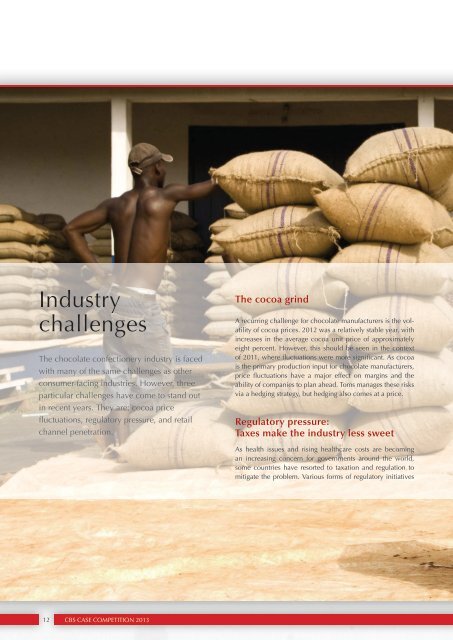Untitled - CBS Observer
Untitled - CBS Observer Untitled - CBS Observer
Industry challenges The chocolate confectionery industry is faced with many of the same challenges as other consumer-facing industries. However, three particular challenges have come to stand out in recent years. They are: cocoa price fluctuations, regulatory pressure, and retail channel penetration. The cocoa grind A recurring challenge for chocolate manufacturers is the volatility of cocoa prices. 2012 was a relatively stable year, with increases in the average cocoa unit price of approximately eight percent. However, this should be seen in the context of 2011, where fluctuations were more significant. As cocoa is the primary production input for chocolate manufacturers, price fluctuations have a major effect on margins and the ability of companies to plan ahead. Toms manages these risks via a hedging strategy, but hedging also comes at a price. Regulatory pressure: Taxes make the industry less sweet As health issues and rising healthcare costs are becoming an increasing concern for governments around the world, some countries have resorted to taxation and regulation to mitigate the problem. Various forms of regulatory initiatives designed to target unhealthy food products have been widely discussed and implemented in some countries already. As a consequence of targeted taxation, margin pressures have made mass-market confectionery products less attractive for producers. Denmark is one of the frontrunners within this area, having introduced heavy confectionery taxation. With Toms’ reliance on the Danish market, the taxation has had a significant impact on the company’s margins. The retail barrier The importance of brand recognition in chocolate purchases cannot be understated. The majority of chocolate purchases are made based on brands the consumer knows. The retail stage therefore poses the largest entry barrier in the chocolate industry. A brand name is a defining element of market power for a chocolate manufacturer – and it comes at a cost. Large investments in product development and marketing are necessary to build and maintain a strong position. Many of the large scale chocolate distribution channels have stringent requirements for their suppliers that include listing fees and marketing spending. In developed markets, traditional retailers such as supermarkets are taking over ever larger shares of food product purchases. In Denmark, the retail market is dominated by only a handful of supermarket chains. Two of those, Dansk Supermarked and Coop Danmark, have the majority of the market share. This gives them immense purchasing power and thus strengthens their ability to influence prices and terms. Since retailer strength and barriers are a factor in many developed markets, it is a variable that smaller chocolate manufacturers must recognize when they enter new markets. 12 CBS CASE COMPETITION 2013 13
- Page 2: Introduction It was a cold morning
- Page 6: “ Product portfolio As a result o
- Page 10: Trends in the chocolate confectione
- Page 16: In the chocolate value chain, proce
- Page 20: “ Toms’ strategy Tasteful momen
- Page 24: Appendix A: Financial statements Ba
- Page 28: Case Writers Andreas Holmbom Niklas
Industry<br />
challenges<br />
The chocolate confectionery industry is faced<br />
with many of the same challenges as other<br />
consumer-facing industries. However, three<br />
particular challenges have come to stand out<br />
in recent years. They are: cocoa price<br />
fluctuations, regulatory pressure, and retail<br />
channel penetration.<br />
The cocoa grind<br />
A recurring challenge for chocolate manufacturers is the volatility<br />
of cocoa prices. 2012 was a relatively stable year, with<br />
increases in the average cocoa unit price of approximately<br />
eight percent. However, this should be seen in the context<br />
of 2011, where fluctuations were more significant. As cocoa<br />
is the primary production input for chocolate manufacturers,<br />
price fluctuations have a major effect on margins and the<br />
ability of companies to plan ahead. Toms manages these risks<br />
via a hedging strategy, but hedging also comes at a price.<br />
Regulatory pressure:<br />
Taxes make the industry less sweet<br />
As health issues and rising healthcare costs are becoming<br />
an increasing concern for governments around the world,<br />
some countries have resorted to taxation and regulation to<br />
mitigate the problem. Various forms of regulatory initiatives<br />
designed to target unhealthy food products have been widely<br />
discussed and implemented in some countries already. As<br />
a consequence of targeted taxation, margin pressures have<br />
made mass-market confectionery products less attractive for<br />
producers. Denmark is one of the frontrunners within this<br />
area, having introduced heavy confectionery taxation. With<br />
Toms’ reliance on the Danish market, the taxation has had a<br />
significant impact on the company’s margins.<br />
The retail barrier<br />
The importance of brand recognition in chocolate purchases<br />
cannot be understated. The majority of chocolate purchases<br />
are made based on brands the consumer knows. The retail<br />
stage therefore poses the largest entry barrier in the chocolate<br />
industry. A brand name is a defining element of market<br />
power for a chocolate manufacturer – and it comes at a cost.<br />
Large investments in product development and marketing are<br />
necessary to build and maintain a strong position. Many of<br />
the large scale chocolate distribution channels have stringent<br />
requirements for their suppliers that include listing fees and<br />
marketing spending. In developed markets, traditional retailers<br />
such as supermarkets are taking over ever larger shares<br />
of food product purchases. In Denmark, the retail market is<br />
dominated by only a handful of supermarket chains. Two of<br />
those, Dansk Supermarked and Coop Danmark, have the<br />
majority of the market share. This gives them immense purchasing<br />
power and thus strengthens their ability to influence<br />
prices and terms. Since retailer strength and barriers are a<br />
factor in many developed markets, it is a variable that smaller<br />
chocolate manufacturers must recognize when they enter<br />
new markets.<br />
12 <strong>CBS</strong> CASE COMPETITION 2013<br />
13



